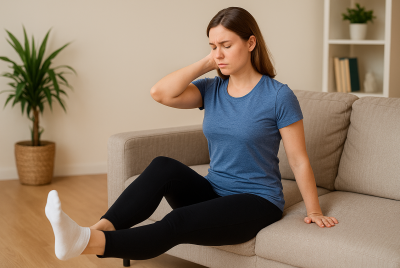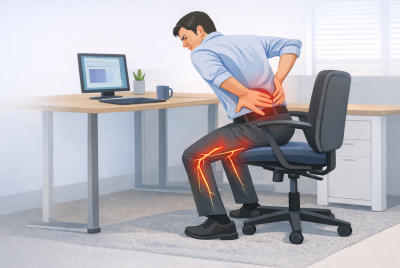Sleeping with Sciatic Nerve Pain
Discover expert tips for sleeping with sciatic nerve pain. Improve sleep quality and alleviate discomfort with our helpful advice! As someone passionate about sciatica health and eager to provide helpful suggestions, I understand the challenges it can pose, especially when it comes to getting a good night’s sleep. Sciatica, often characterized by radiating pain from the lower back down the leg, can make finding a comfortable sleeping position seem like an impossible task. However, with the right strategies and adjustments, it is possible to improve sleep quality and alleviate some of the discomfort associated with sciatic nerve pain.
Understanding Sciatic Nerve Pain
Before delving into sleeping strategies, it’s essential to understand what sciatic nerve pain is and how it can affect sleep. Sciatica occurs when the sciatic nerve, which runs from the lower back through the hips and down each leg, becomes compressed or irritated. This compression can result in pain, numbness, tingling, or weakness in the lower back, buttocks, legs, or feet. These symptoms often worsen at night, making it challenging to find a comfortable sleeping position.
Importance of Sleep for Sciatic Nerve Pain
Sleep plays a crucial role in managing pain and promoting healing, making it essential for those dealing with sciatic nerve pain to prioritize quality sleep. Lack of sleep can exacerbate pain perception and interfere with the body’s ability to repair and regenerate tissues. Therefore, finding ways to improve sleep comfort and duration is vital for managing sciatic nerve pain effectively.
Best Sleeping Positions for Sciatic Nerve Pain
Finding the right sleeping position can make a significant difference in alleviating sciatic nerve pain and improving sleep quality. Here are some recommended sleeping positions:
Side Sleeping with a Pillow Between the Knees: This position helps align the spine and reduce pressure on the lower back and hips. Placing a pillow between the knees can further support proper spinal alignment and relieve tension on the sciatic nerve.
Sleeping on the Back with a Pillow Under the Knees: Back sleeping with a pillow under the knees can help maintain the natural curvature of the spine and reduce strain on the lower back. This position also promotes even weight distribution, minimizing pressure on the sciatic nerve.
Avoiding Sleeping on the Stomach: Sleeping on the stomach can exacerbate sciatic nerve pain by causing the spine to arch unnaturally and increasing strain on the lower back and hips. It’s best to avoid this position if you have sciatica.
The Best Sleeping Position for Back Pain, Neck Pain, and Sciatica
Pillows and Mattresses for Sciatic Nerve Pain
In addition to adopting proper sleeping positions, choosing the right pillows and mattresses can further enhance sleep comfort for those with sciatic nerve pain. Here are some tips:
Choosing a Supportive Mattress: Opt for a medium-firm mattress that provides adequate support for the spine while contouring to the body’s natural curves. Memory foam or hybrid mattresses with targeted support zones can be particularly beneficial for relieving pressure points.
Selecting the Right Pillows: Use pillows that support proper spinal alignment and reduce pressure on the lower back and hips. A contoured cervical pillow can help maintain neutral neck alignment, while a body pillow or wedge pillow can provide additional support for side sleeping.
Sleeping Tips and Techniques
In addition to optimizing sleeping positions and bedding, incorporating relaxation techniques and creating a conducive sleep environment can further improve sleep quality for individuals with sciatic nerve pain. Here are some tips:
Creating a Conducive Sleep Environment: Keep your bedroom dark, quiet, and cool to promote restful sleep. Invest in blackout curtains or a white noise machine if necessary.
Practicing Relaxation Techniques: Engage in relaxation techniques such as deep breathing, progressive muscle relaxation, or gentle stretching before bedtime to ease tension and prepare the body for sleep.
Other Lifestyle Modifications
In addition to optimizing sleep habits, making lifestyle modifications can help manage sciatic nerve pain and improve overall well-being. Here are some recommendations:
Regular Exercise
Incorporate gentle exercises such as walking, swimming, tai chi, pilates, or yoga into your daily routine to improve flexibility, strengthen core muscles, and alleviate pressure on the sciatic nerve.
Proper Posture
Maintain good posture throughout the day by sitting and standing with the spine aligned and avoiding prolonged periods of sitting or standing in one position. Use ergonomic furniture and supportive cushions to minimize strain on the lower back.
When to Seek Professional Help
While self-care strategies can provide relief for mild to moderate sciatic nerve pain, it’s essential to seek medical attention if symptoms persist or worsen. Here are some signs that indicate the need for professional evaluation and treatment:
- Persistent or severe pain that interferes with daily activities.
- Progressive weakness or numbness in the legs or feet.
- Difficulty controlling bladder or bowel function.
- Fever, chills, or unexplained weight loss accompany symptoms.
FAQs Related to Sleeping with Sciatic Nerve Pain
Can sciatic nerve pain be cured completely?
While sciatic nerve pain can be managed effectively with lifestyle modifications and treatment, it may not always be possible to cure it completely. However, many individuals experience significant relief from symptoms with proper care and management.
Is surgery necessary for treating sciatica?
In most cases, surgery is not necessary for treating sciatica. Conservative treatments such as physical therapy, medication, and lifestyle modifications are often effective in alleviating symptoms. Surgery may be considered if symptoms are severe, persistent, or do not respond to conservative treatments.
How long does it take to recover from sciatic nerve pain?
The recovery time for sciatic nerve pain varies depending on the severity of symptoms and the effectiveness of treatment. While some individuals may experience relief within a few weeks with proper care, others may require several months or longer to achieve full recovery.
Can sleeping on a firm mattress worsen sciatic nerve pain?
Sleeping on a firm mattress can exacerbate sciatic nerve pain by placing additional pressure on the lower back and hips. It’s best to choose a medium-firm mattress that provides adequate support while contouring the body’s natural curves.
Are there any exercises that can aggravate sciatic nerve pain?
While exercise is beneficial for managing sciatic nerve pain, certain activities or movements may exacerbate symptoms. It’s essential to avoid high-impact exercises or movements that involve twisting or bending the spine excessively. Instead, focus on gentle exercises that promote flexibility, strength, and proper alignment.
Sleeping with Sciatic Nerve Pain – Conclusion
Managing sciatic nerve pain can be challenging, especially when it comes to getting a good night’s sleep. However, by implementing the strategies outlined above, such as adopting proper sleeping positions, investing in supportive bedding, and practicing relaxation techniques, individuals with sciatica can improve sleep quality and reduce discomfort. Remember to listen to your body, prioritize self-care, and seek professional help if needed to manage sciatic nerve pain and promote overall well-being effectively.
Disclaimer
This article is for informational purposes only and is not a substitute for professional medical advice, diagnosis, or treatment. Always consult with your healthcare provider before starting a new exercise or stretching routine, especially if you have existing back or nerve conditions.
👉 Explore more:





